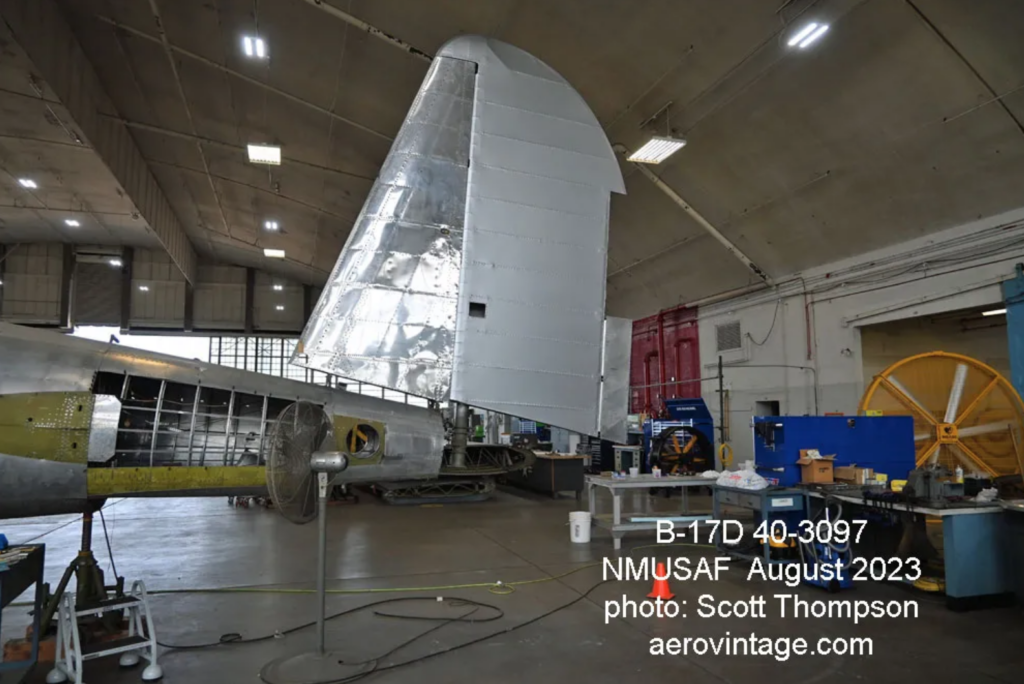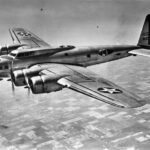Back in April, the National Museum of the U.S. Air Force (NMUSAF) announced that they would resume the restoration of Boeing B-17D Flying Fortress 40-3097, nicknamed The Swoose, one of the most storied survivors of its breed. Being the oldest intact Flying Fortress extant, this is both a restoration and conservation project. Scott Thompson of AeroVintage stopped by the museum and produced the following report.
By Scott Thompson of Aero Vintage
The sole remaining early “shark fin” B-17, B-17D 40-3097, is in the initial stages of a restoration or, probably better put, reassembly and preservation at the shops of the National Museum of The United States Air Force (NMUSAF) at Wright-Patterson AFB in Ohio. This is exciting for anyone familiar with the history of this B-17D, best known as The Swoose, as it will finally be reassembled and put on display after nearly seventy years of storage by the National Air Museum, later the National Air and Space Museum, and finally by the NMUSAF. I had the opportunity to visit the airplane and spent some time looking at it in detail. There is much to look at.
First off, though, it is the announced intention of the NMUSAF to restore the B-17D to its last wartime configuration…that of a VIP transport for Gen. George Brett who was the commander of the Caribbean Defense Command and Panama Canal Department from November 1942 until April 1945. When this intention was first announced back in April 2023, it was received with some disappointment among many B-17 enthusiasts.
There are really three points of this aircraft’s history that represent important historical milestones: a factory-fresh natural metal finish B-17D off the assembly line, the B-17D as it served as a combat bomber in the first month of World War II in the Pacific, or as the VIP transport. Given the trend of many museums to preserve rather than destroy historical artifacts, the decision was made to return 40-3097 to its last configuration as a transport.
Indeed, much of the airplane changed from its delivery at Boeing Field in April 1941 (one of only 42 B-17Ds built) until its retirement to Kingman Field in December 1945. To undo those modifications made through the years would have destroyed some basic history of this B-17. So, I for one, am content with the decision by the NMUSAF. Among other things, it will make the reassembly much easier to accomplish. Most of the components are on hand, and the documented transport interior will be restored or recreated as needed.
The finish will return to the natural metal finish of 1945 prior to it going on display as a war memorial at Los Angeles in 1946. A major challenge of the NMUSAF team will be what to do with the distinctive markings on the airplane, many of which it wore in the last months of its service, some of which were added prior to it going on public display in 1946.
Especially notable among these are the flags and markings on the right side of the nose. When initial work was done on the B-17D by the NMUSAF back in 2009-2010 (before work was sidelined by the restoration of B-17F 41-24485 Memphis Belle, the mindset at that time was to restore the bomber and the nose skin was removed with the flags and markings intact. The nose was going to be reskinned and, in fact, the skin on the left side of the nose was replaced. However, with the change of direction to preserve instead of restore The Swoose, that removed skin with the flags and markings has been reattached back in position…not yet riveted but held in place by clecoes.
The notable history of this particular B-17 won’t be recounted in detail here. It is covered elsewhere, one good source being Final Cut: The Post-War B-17 Flying Fortress and Survivors. Suffice it to say that, briefly, it was on hand at Del Monte Field in the Philippines on the first day of the war, avoiding destruction by not being at Clark Field near Manila. It fought with the meager remainders of U.S. air power through the first month of the war, being badly damaged several times. Known then as Ole Betsy, the worn-out B-17 was withdrawn from service after January 11, 1942, barely five weeks into the Pacific war. It was rebuilt as a transport and served General Brett from then on until the war ended. In December 1945 it was sent to Kingman for scrapping, but was saved as it was claimed by the city of Los Angeles for use as a war memorial, helped along by its wartime pilot, Frank Kurtz, who pretty much arranged the whole thing. It was in excellent VIP transport condition at Kingman and was put back into flying condition. However, Kurtz and team did not want The Swoose displayed as a transport, so it was first flown to March Field near Riverside, California, and quickly repainted with olive drab upper surfaces and black (?) lower surfaces (perhaps no neutral gray paint available?) with early Air Corps insignia.
It was then delivered by Kurtz to the city of the Angels in early April 1946. It was nominally displayed in Los Angeles for three years and then, with a sense of relief, turned over to the National Air Museum. It was put back into flying condition, again by Kurtz, and flown first to what is now O’Hare Airport in Chicago and stored, and then on to Pyote, Texas, in 1950 and stored, and finally on to Andrews AFB in Maryland, in 1953. It was then disassembled and stored, once again, and not seen by the general public since. The NMUSAF got it in a trade with the NASM in 2008, and now, fifteen years later, it is receiving some much-deserved attention.
The NMUSAF is expecting a seven-year restoration…er, preservation…project, so it might go on display circa 2031 at the museum. That seems a bit long given that most of the airframe components are on-hand and available. The transport interior will be challenging, no doubt, but it is presumed all the available wiring, cabling, and other systems will only be preserved and not replaced. The engines will require at least a cosmetic cleaning and completion for a static display. The narrow chord ‘broomstick’ propellers of the early B-17s will also be fitted.
Seven years is a bit down the road before it might be on display, and lots can change in seven years. Nonetheless, the NMUSAF now has a firm plan for B-17D 40-3097 and we all will watch with much anticipation as it comes back together.
I need to thank the gracious staff of the NMUSAF for arranging this visit to see the airplane. For more information on the project, visit this dedicated page at the NMUSAF website.
*And, I’ll recommend two other fine sources that address B-17D 40-3097 in some detail (besides Final Cut, of course): The first is the 1993 book The Swoose: Odyssey of a B-17 by Herbert S. Brownstein which is devoted to the history of this airplane. The second is Fortress Against the Sun: The B-17 Flying Fortress in the Pacific by Gene Eric Salecker. Both are excellent in telling the story of the airplane in the first case and the times in the second case.
Many thanks indeed to Scott A. Thompson for allowing us to reproduce this article describing The Swoose’s present condition… his book, Final Cut: The Post-War B-17 Flying Fortress and Survivors as well as other titles is the gold standard when it comes to the airframe history it describes!







































